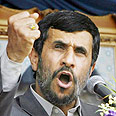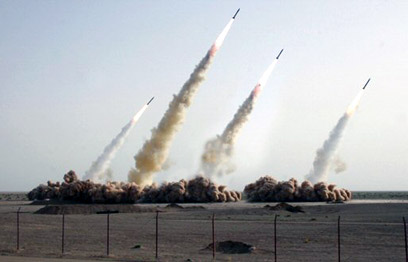
Is Iran changing its nuclear strategy?
US, European experts believe Iran already has full nuclear capabilities but has chosen to appease international community, suspend uranium enrichment in favor of investing in new centrifuge formation, which in time would allow it to reach its nuclear goals doubly fast
The international pressure and the technical difficulties involved in uranium enrichment have prompted Iran to change its nuclear development strategy, Western diplomats and nuclear experts said Thursday.
Based on the recent International Atomic Energy Agency (IAEA) and intelligence reports, the Iranians are no longer aggressively trying to create fissionable uranium.
Fissionable uranium contains 90% of uranium isotope 235, which can be used to create a nuclear warhead. According to assessments, the Iranians are no longer developing new warheads for the missiles they posses and are now funneling all their resources towards building new, modern industrial formations which would eventually be able to enrich uranium and manufacture warheads much faster.
At the core of the new formation is said to be an array of new centrifuges, built based on information sold to Iran by Pakistani scientist Abd al-Kader Khan. The new Pakistani P-2 centrifuges – or IR-2 and IR-3, as they are called in Iran – can enrich uranium at double and triple the speed than the 3,000 old centrifuges installed in Iran's Natanz nuclear facility.
Having two sets of centrifuges, said Tehran, will allow it to cut down the time in needs to produce fissionable uranium by two-thirds.
The Natanz facility already sports 300 of the new centrifuges, but since Iran is adamant that its nuclear program is being developed for peaceful purposes, it says it will not be using the new infrastructure to its full capacity, and will not be producing fissionable uranium unless the Iranian leadership decides it needs to produce operational nuclear weapons.
When that moment comes and production is stepped up, Iran would be able to have several operational nuclear warheads within one year's time.
Threshold capabilities
The international intelligence community defines Iran as having "threshold capabilities" – the same as Japan, Germany and Brazil, for example – countries which have the technical ability and know-how, but have chosen not to develop nuclear weapons, opting to sign the Nuclear Nonproliferation Treaty (NPT) instead. Counties who are obligated by the NPT are allowed to develop nuclear energy for peaceful purposes, such as for medical or alternative energy use; and are allowed to acquire the necessary materials, under strict IAEA supervision.
Iran has also signed the NPT and as long as it agrees to have IAES inspectors monitor it actions – and should it be able to successfully form its new centrifuge formation – is can be considered a country with legitimate threshold capabilities.
Only if it is proven that Iran is enriching uranium for the clear purpose of building a bomb, would the international community have merit to apply severe sanctions against it, such as an oil embargo and a naval blockade.
After its last inspection of the Iranian facilities, the IAEA has concluded that between December of 2007 and May of 2008 Iran has pumped 2.3 tons of Uranium Hexafluoride gas – UF6 – to the centrifuge formation in Natanz, producing about 300 lbs of low-grade uranium. In layman's terms – Iran already posses the ability to produce any kind of enriched uranium it wants, including full-fledged fissionable uranium. Using the existing centrifuge formation, Iran would need between three to five years before it can produce enough materials to actually build a small nuclear bomb – a rate the Iranians are not happy about.

Iran's recent missile test fire (Photo: AFP)
True, the new centrifuges would also be installed in Natanz – which is under heavy UN supervision – but should the new formation work properly, the Iranians would be able to produce large amounts of low-grade uranium, suitable for civilian needs, and ready to be upgraded for military use within months.
Ambiguity vs. incentives
American and European nuclear experts are well aware of that possibility, as well as the possibility that Iran can build covert nuclear facilities, where the new centrifuges would be made fully operational and unsupervised. That belief prompted Washington and the EU to demand Iran not only suspend uranium enrichment, but also its entire nuclear program, setting the suspension as their prerequisite to lifting all sanctions and awarding Tehran with an incentives package it so desperately needs and wants.
Iran, on its part, has informed EU Foreign Policy Chief Javier Solana it would gladly negotiate the incentives package, but said nothing to indicate it would be willing to change or suspend its nuclear program.
The ambiguity serves the Iranians well. The British newspaper Daily Telegraph reported recently that Iran has formed a series of dummy-corporations focused on centrifuge development that operating from within apartment buildings in Tehran.
The companies' location serves two purposes: It hide their true nature, while making it extremely difficult for any military to target them. The Iranians assume – and rightfully so – that both the Americans and the Israelis would be less likely to target densely populated urban areas. It allows them to continue developing and testing their new capabilities away from prying international eyes.
Disconcerting findings
The IAEA's latest report of Iranian nuclear capabilities noted several covert developments "which should be cause for some concern": Developments of nuclear detonators, high-end experiments involving conventional explosives made to accelerate nuclear warheads' fission and underground nuclear testing facilities.
The most disconcerting find, however was that of computer files suggesting Iran already possesses – and may have already tested – a full-fledged nuclear warhead.
To make matters worse, the Swiss authorities have recently discovered even more computer files suggesting Abd al-Kader Khan did more than draw plans for a simple nuclear warhead – he may have also provided the Iranians with the blueprints for a new, extremely small nuclear warhead, which can be installed atop ballistic missiles.

Undergoing an upgrade. The Nataz nuclear facility (Photo: AFP)
There is, however, no evidence to suggest that Kahn also provided them with the necessary information on how to actually manufacture the warheads without spending valuable time and resources on development and testing.
The IAEA findings, however, did have a positive side, at least as far as Israel is concerned: They refuted the US' intelligence report, which suggested that Iran had effectively suspended is nuclear program.
It further indicated that the international community's policy of isolating Iran and implementing sanctions affected the Islamic Republic much more than its leaders would have the world believe, increasing the chances of it yielding to the world's demands, to some extent, at least.
Timing is everything
A different conclusion that may also be derived from the report is that anyone planning to strike Iran need not rush: Bombing the existing nuclear facilities would slow Iran down, but an effective assault, which would serve to neutralize Tehran's nuclear program could only be done if and when Iran will finish installing its new centrifuge formations, providing, of course, that whoever is launching the strike has the exact location of the facilities.
Another possibility is striking Iran's oil fields and launching pads. A successful strike of that nature would damage Iran's financial resources considerably and force Tehran to focus its efforts on rebuilding its infrastructure.
Any such strike, however, is likely to cause an immediate regional flare-up and a sharp spike in oil prices. Whoever initiates the strike is likely to face the international community's condemnation for spilling innocent blood, destabilizing the Middle East and wreaking the financial havoc that would surely follow any massive increase in oil process.
Moreover, such a strike is unlikely to deter Iran enough to make it give up its nuclear ambitions altogether. It is more likely to cause the exact opposite, and give Iran the justification it needs to develop a judgment day weapon.
For these reasons, to name a few, the US would rather Israel refrain from striking Iran at this time. For the time being, at least, it appears to be right.










